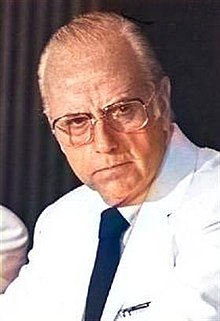Alejandro Armendáriz
Alejandro Armendáriz | |
|---|---|
 | |
| National Deputy | |
| In office 10 December 1991 – 10 December 1995 | |
| Constituency | Buenos Aires Province |
| Governor of Buenos Aires | |
| In office 11 December 1983 – 11 December 1987 | |
| Vice Governor | Elva Roulet |
| Preceded by | Jorge Aguado |
| Succeeded by | Antonio Cafiero |
| Provincial Deputy of Buenos Aires | |
| In office 12 October 1965 – 28 June 1966 | |
| Constituency | Seventh Electoral Section |
| Personal details | |
| Born | 5 June 1923 Saladillo, Buenos Aires Province Argentina |
| Died | 7 August 2005 (aged 82) |
| Political party | Radical Civic Union |
| Profession | Physician |
Alejandro Armendáriz (5 June 1923 – 7 August 2005) was an Argentine physician and politician.
Life and times
Early career
Armendáriz was born in
Practicing medicine, he became affiliated to the centrist
The 1966 deposal of President
Governor of Argentina's largest province
Two out of three residents in the province live in the Greater Buenos Aires area, a quiltwork of largely working-class suburbs long aligned with Perón's populist Justicialist Party. Armendáriz selected as his running mate Elva Roulet, an architect from the Greater Buenos Aires suburb of San Martín whose personable demeanor complemented Armendáriz's reserved nature well.[1]
Polls gave neither man an edge, and on election day, October 30, as Argentines gathered in a then-record turnout, the Justicialist candidate, Herminio Iglesias, threw a (premature) "victory rally" in which a coffin draped in the UCR colors was burned before the television cameras. The macabre scene ignited the electorate's bitter memories of Isabel Perón's chaotic 1974-76 presidency and helped result in a solid victory for both Alfonsín and Armendáriz.[3] Excluding blank and invalid votes, of 5.4 million cast, Armendáriz received 2.8 million (52%) - soundly defeating the odds-on favorite, Iglesias, by 12%.[4]
Inheriting a province reeling from the effects of a national
His social policy was equally vigorous. He added 24,000 teachers to the strained public school system, while having 560 schools built and establishing building administration posts to remodel many others. Increasing spending on poverty relief programs, his efforts began or completed 37,000 public housing units, while extending public running water to around a million people and public sewers to 600,000 households (over 2 million people). A physician by vocation, he had clinics and hospitals built totaling 54,000 m² (580,000 ft²), while incorporating six bankrupt facilities into the provincial aegis (including the Saladillo Hospital). Severe flooding in the north of the province (the center of the nation's grain belt) in 1984 led the Governor to enact the Master Hydrostructural Plan, which built numerous needed levees and canals, while closing illegally built ones.[5]
These and other works could not overcome voters' growing disapproval of President Alfonsín's policy of wage freezes and credit controls, which the opposition Justicialist Party blamed for sliding living standards.[6] Anti-incumbent sentiment and fallout from the 1986 indictment of Armendáriz's son-in-law, José Luis Nicora, for embezzlement while Mayor of Magdalena[7] cost his party the Governorship in the September 1987 election. Justicialist nominee Antonio Cafiero, an economist and legislator close to the late Juan Perón, received 47% of the vote, defeating UCR nominee Juan Manuel Casella by 7 points.[8]
Later life
Alfonsín appointed Armendáriz head of the Crisis Management Commission overseeing
A September 1997 automobile accident nearly cost Armendáriz his life, and he retired from Congress.[9] Remaining politically active in the provincial capital of La Plata, he suffered another serious accident, at his office, in April 2004.[2] Unable to recover, Alejandro Armendáriz died at his Saladillo home in 2005. He was 82.
A distinguished Argentine physician, politician and lawmaker, he was survived by his widow, children and 7 grandchildren. His legacy of transparency and efficiency earned him the respect of figures from both parties.[5]
References and external links
- ^ a b Diccionario Radical: Alejandro Armendáriz Archived 2008-04-05 at the Wayback Machine (in Spanish)
- ^ a b Clarín Archived 2008-08-27 at the Wayback Machine (in Spanish)
- ^ Todo Argentina: 1983 Archived 2009-03-04 at the Wayback Machine (in Spanish)
- ^ "Andy Tow's Electoral Atlas of Argentina: 1983". Archived from the original on 11 October 2007. Retrieved 27 April 2009.
- ^ a b c d Saladillo municipal web site (in Spanish)
- ^ Todo Argentina: 1987 Archived 2009-04-05 at the Wayback Machine (in Spanish)
- ^ Clarín Archived 2003-03-14 at the Wayback Machine (in Spanish)
- ^ "Andy Tow's Electoral Atlas of Argentina: 1987". Archived from the original on 20 October 2007. Retrieved 27 April 2009.
- ^ Saladillo municipal website Archived 2009-06-09 at the Wayback Machine (in Spanish)
